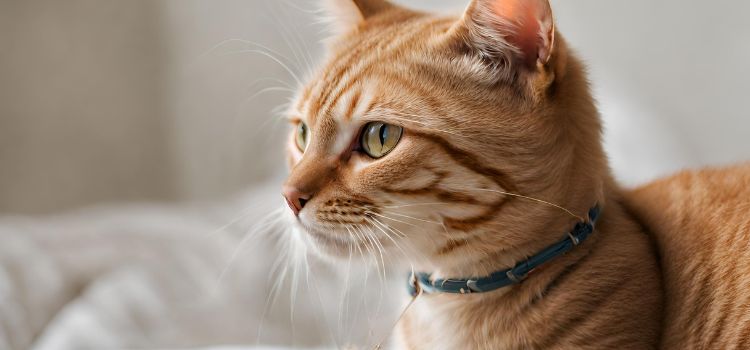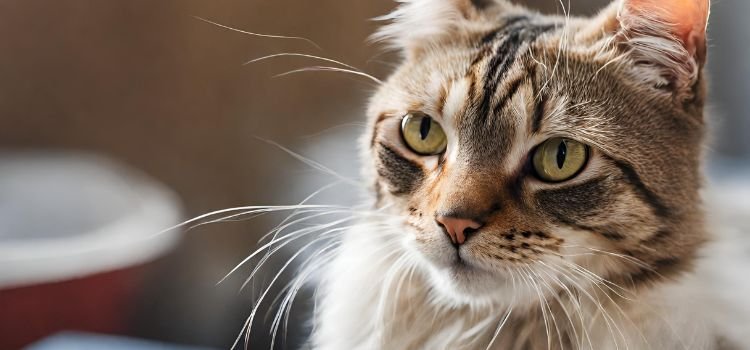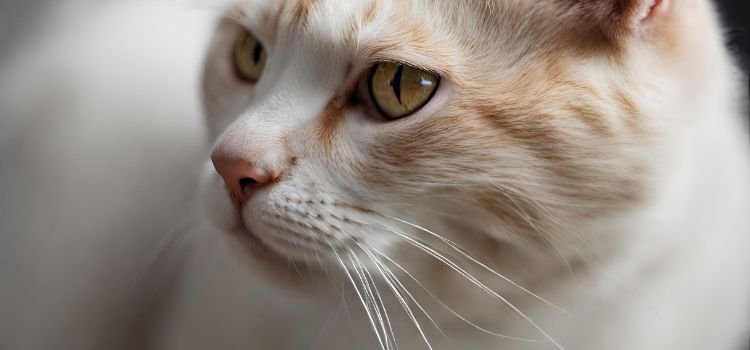As an Amazon Associate committed to the mission of improving the lives of our readers, Live-Clear.com receives a small commission from eligible purchases made through our affiliate links. This revenue enables us to keep producing insightful articles and other material.
To treat stick tight fleas on cats, a safe and effective approach is to manually remove the fleas with tweezers and apply an insecticidal spray to your cat. These fleas, otherwise known as Echidnophaga gallinacea, embed themselves into the cat’s skin and can cause irritation, anemia, and infections.
Removing stick tight fleas from cats requires a careful and effective approach to prevent further harm to your furry friend. Infestations not only cause irritation and discomfort but can also lead to anemia and infections. As a responsible pet owner, it’s crucial to know the best practices in treating these pesky fleas.

This article will guide you on how to treat stick tight fleas on cats and provide you with expert advice on how to prevent them in the future.
The Dangers Of Stick Tight Fleas On Cats
Cats that play outside can get different kinds of fleas that usually jump onto them. Stick Tight fleas are among these pesky insects that pet owners should watch out for. What makes these fleas dangerous is that they are not like other fleas that jump around the cat’s fur. Stick Tight fleas burrow under the cat’s skin and latch onto them. This can cause a range of health problems for your cats.
Health Risks Of Stick Tight Fleas on Cats
Stick Tight fleas pose several health risks to cats. When these fleas latch onto the cat’s skin, they create a small wound that can get infected and cause discomfort. Moreover, stick tight fleas feeding on the cat’s blood can lead to anemia, which weakens the cat’s immune system and makes them vulnerable to other infections.
These fleas can also lead to hair loss, especially when they gather in large numbers. Your cat may often try to scratch off the fleas, leading to the loss of fur around the affected area. This can leave the cat’s skin exposed to the environment, making them more prone to infections.
Transmission To Humans
Stick Tight fleas can also transmit to humans. While these fleas prefer to feed on the cat’s blood, they may latch onto a human’s skin and create a wound. This can be quite painful and uncomfortable for us. Additionally, stick tight fleas are known to carry various diseases that can pass onto humans through their bites.
It’s crucial to take preventive measures and protect your cat from stick tight fleas. Ensure you comb your cat regularly and check for signs of fleas. If you notice any, take immediate action to avoid further problems. Always consult your vet for the best possible treatment options.
Prevention Methods Of Stick Tight Fleas on Cats
One effective prevention method for treating stick tight fleas on cats is to regularly groom your pet to remove fleas and their eggs. Additionally, using flea prevention medication can also help keep these harmful pests at bay. Seeking veterinary advice can provide tailored treatments based on your cat’s age, health and circumstances.
Stick Tight Fleas are blood-sucking parasites that infest both indoor and outdoor cats. Although these fleas are not as harmful as other fleas, it’s still necessary to take steps to prevent them from infesting your cat. Here are the most effective prevention methods you can use to keep your feline friend flea-free and healthy.
Regular Grooming Practices
One of the best ways to prevent Stick Tight Fleas on your cat is by grooming them regularly. Not only does grooming help reduce the risk of flea infestation, but it also promotes healthy skin and coat. Make sure you comb and brush your cat’s fur daily, especially if they spend time outdoors. Regular grooming can also help you spot any early signs of flea infestation and handle the issue before it becomes problematic.
Peripherals
Another crucial method to prevent Stick Tight Fleas on Cats is by using peripherals such as flea collars, sprays, and shampoos. These peripherals are specifically designed to repel and kill fleas before they can infest your furry friend. You can also use spot-on treatments that are applied to the skin at the base of your cat’s neck. However, be cautious while using peripherals and always consult your vet before applying any treatment.
Household Cleanliness
Maintaining a clean and flea-free environment is another effective method to prevent Stick Tight Fleas on Cats. Make sure you vacuum your carpets and rugs regularly. Wash your cat’s bedding, blankets, and toys regularly with hot water to kill fleas and their larvae. Also, treat your house for fleas, especially in areas where your cat spends most of their time. In conclusion, with the above prevention methods, you can prevent Stick Tight Fleas and create a healthy and happy environment for your cat. By combining preventive measures with regular checkups, you can keep your beloved feline companion free of fleas and offer them an excellent quality of life.

Home Remedies To Treat Stick Tight Fleas
Stick tight fleas are small and difficult to remove. They burrow their head into the skin of the cats which makes it hard to remove them without causing further damage or pain to the cat. These fleas can cause various diseases such as anemia and infection, and can be a significant nuisance to your cat.
Essential Oils To Treat Stick Tight Fleas
Essential oils have become a popular alternative to traditional flea treatments because they are natural and safe for cats. Some essential oils that are effective against stick tight fleas include lavender oil, peppermint oil, and cedar oil. Mix a few drops of the essential oil with a carrier oil such as coconut oil and apply it to your cat’s skin. The scent of the oil deters the fleas, and the oil suffocates them so that they die off. Keep in mind that some essential oils can be toxic to cats, so be sure to do your research before using them.
Diatomaceous Earth To Treat Stick Tight Fleas
Diatomaceous earth is a soft, powdery substance that is made from the fossilized remains of tiny aquatic organisms. It is an effective and natural way to get rid of stick tight fleas. Sprinkle a small amount of diatomaceous earth on your cat’s fur and rub it in gently. The powder works by dehydrating the fleas, causing them to die off. It is essential to use food-grade diatomaceous earth and not the one meant for pool filters.
Apple Cider Vinegar To Treat Stick Tight Fleas
Apple cider vinegar is a versatile home remedy that has antifungal, antiviral, and antibacterial properties, which makes it an excellent remedy against stick tight fleas. Mix equal parts water and apple cider vinegar in a spray bottle and spray it on your cat’s fur. The acidity of the vinegar makes it difficult for the fleas to survive. Vinegar can be a bit irritating and may lead to dry skin, so don’t use it too often.
Home remedies like essential oils, diatomaceous earth, and apple cider vinegar can be very effective in treating stick tight fleas on cats. However, keep in mind that while natural remedies are generally considered safe, it’s always best to consult your veterinarian before trying any new treatment on your cat. Treating fleas is essential for the health and well-being of your cat.
Over-the-counter Products
To treat stick tight fleas on cats, over-the-counter products such as flea combs, shampoos, and topical treatments can be effective. It is important to follow the instructions carefully and consult with a veterinarian before use.
If you notice that your feline friend has stick tight fleas, you may be desperate to help them find relief. There are many over-the-counter products available that can be used to treat stick tight fleas. However, not all products are created equal, and some may be more effective than others. When choosing a product, it’s essential to consider its active ingredients, potential safety concerns, and overall effectiveness.
Active Ingredients To Look For
Some active ingredients found in over-the-counter products can help to kill stick tight fleas on cats. They include:
- Pyrethrins: This is a natural insecticide that is derived from chrysanthemum flowers. Pyrethrins are toxic to fleas but are considered safe for cats. However, they can be harmful to fish and should not be used around aquariums.
- Pyrethroids: These are synthetic versions of pyrethrins and are also effective in killing fleas. They are generally considered safe for use around cats, but it’s essential to follow the product label carefully.
- Selamectin: This is a prescription-only medication that is effective against stick tight fleas. It’s applied topically once a month and can also help to prevent heartworm and other parasites.

Safety Considerations
When using over-the-counter products to treat stick tight fleas, there are several safety considerations to keep in mind. These include:
- Cat-specific products: It’s essential to choose a product that is specifically formulated for cats. Using a dog flea treatment can be dangerous and can cause harm to your feline friend.
- Age and weight: Always check the product label and make sure you are using the right dosage for your cat’s age and weight.
- Application: Follow the product label carefully and apply the product as directed. Some products may require multiple applications, so be sure to read the instructions carefully.
- Side effects: Some cats may experience side effects from flea treatments, including hair loss, skin irritation, and vomiting. If you notice any adverse reactions, stop using the product immediately and contact your veterinarian.
Remember to always read the label carefully and follow the product instructions when using over-the-counter products to treat stick tight fleas on your cat. It’s also important to consult with your veterinarian before using any new products, especially if your cat has any underlying health conditions or is taking any medications.
When To See A Vet
Stick tight fleas can be challenging to remove since they cling onto your cat’s skin tightly. If your cat has these fleas, it is best to see a vet for proper treatment.
If your cat has stick tight fleas, it’s essential to seek veterinary care if you notice any unusual symptoms. The presence of these pests can cause severe irritation, discomfort, and pain to your feline friend. Stick tight fleas can lead to severe infestations and may transmit various diseases.
Advanced Infestations
If you notice that your cat’s skin has become raw and inflamed, this could be a sign of an advanced infestation of stick tight fleas. These pests can latch on tightly to your cat’s skin, causing intense itching and discomfort. Your cat may start to scratch excessively and develop open sores or bald spots in the affected areas. In this case, it’s critical to take your cat to the vet for prompt treatment.
Flea-induced Illnesses
Stick tight fleas can also cause various flea-induced illnesses in cats, including flea allergy dermatitis, cat scratch fever, anemia, and tapeworms. If you notice any unusual symptoms such as lethargy, weakness, vomiting, or diarrhea, it’s crucial to take your cat to the vet immediately. Your vet may recommend tests such as blood work or fecal exams to diagnose any underlying conditions caused by stick tight fleas and provide the appropriate treatment.
In conclusion, it’s important to monitor your cat’s health closely if they have stick tight fleas. When left untreated, these pests can cause severe infestations and transmit various diseases. If you notice any unusual symptoms or your cat’s condition worsens, it’s crucial to seek veterinary care promptly.

Conclusion
When you find stick tight fleas on your furry feline, it is important to act quickly to avoid further complications. By following the steps outlined in this guide, you can effectively treat stick tight fleas on your cat and prevent them from returning.
Remember to consult your veterinarian before administering any treatments and closely monitor your cat’s behavior during and after treatment. With patience and care, you can help your cat feel more comfortable and flea-free.
Frequently Asked Questions On How To Treat Stick Tight Fleas On Cats
No, Vaseline does not kill stick tight fleas. It may suffocate some, but it won’t eliminate the infestation. To get rid of stick tight fleas, use insecticides meant for fleas and ticks. Prevent infestations by keeping your pet and surroundings clean and tidy.
Stick tight fleas come from wild animals, such as raccoons, opossums, and squirrels. These fleas infest the animals and can easily jump onto pets or humans. Stick tight fleas can also be found in outdoor areas with thick vegetation, such as tall grasses, shrubs, and bushes.
The best way to treat stubborn fleas on cats is by using a flea comb, topical treatments, or collars. You can also consult with a veterinarian to see if medication or additional options are necessary. Regular grooming and vacuuming can also help prevent future infestations.
Treatment for stick fast fleas require careful removal with tweezers or forceps. Gently grasp the flea as close to the skin as possible, then twist and pull it out. Clean the bite area with antiseptic. Lastly, monitor your pet for any signs of infection and seek veterinary advice if necessary.
Stick tight fleas are tiny fleas that infest a cat’s skin, burying their heads deep into the cat’s flesh to feed on the host’s blood.
Amazon and the Amazon logo are trademarks of Amazon.com, Inc, or its affiliates.



